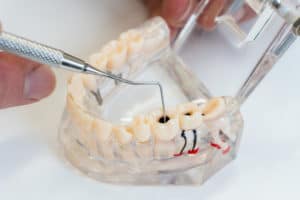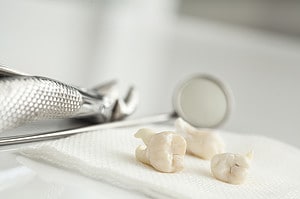Creating a dental crown is a complex and meticulous process that requires the utmost care and precision. It is a process that has been perfected over time to ensure the patient receives the highest quality of care and the most effective treatment.
The crown creation process is lengthy, as numerous steps are involved in crafting a crown designed to last a lifetime. This article will delve into the steps of the crown creation process to give the reader an understanding of how long dental crowns typically take to complete. Furthermore, it will provide insight into potential complications and how to care for the crown once it is placed.
Types of Dental Crowns
Various types of crowns are available, each offering different levels of durability and aesthetic appeal.
Temporary crowns are made of acrylic and are used to protect the tooth until a permanent crown is ready.
Permanent dental crowns are used to cover a tooth to restore its shape, size, and strength and can be made of gold, ceramic, porcelain, or a combination of these materials.
Metal crowns are made of stainless steel or an alloy of gold, palladium, or other metals and are usually used when the cost is a major factor.
Ceramic crowns are made of porcelain and are aesthetically pleasing, making them popular.
Porcelain crowns are also made of porcelain and can be colour-matched to natural teeth, creating a seamless look.
Gold crowns are strong and durable and made of gold alloy, but they are usually more expensive than other options.
Zirconia crowns are made of zirconium oxide and are popular for long-lasting results.
Finally, same-day crowns are made with computer-aided design and manufacturing technology and are ready to be placed on the same day.
Each type of crown offers different benefits and drawbacks, so working with a dental professional to determine the best option for a patient’s needs is important.
Preparing the Tooth for a Crown
Preparing the tooth for a crown may require an extensive examination of the tooth, including X-rays, to ensure the accuracy of the dental crown procedure. Depending on the type of crown, the dentist may need to strengthen weak teeth by using a combination of fillings and crowns or replacing the entire tooth with a dental bridge. If the tooth is decayed, a root canal treatment may be needed before the crown can be placed.
Before the crown can be placed, the tooth must be prepared. This involves removing extensive decay or damaged parts of the tooth and shaping it so the crown will fit properly. The dentist will also take an impression of the prepared tooth to create a model for the crown. The entire process can take several visits to the dental clinic, depending on the type of crown chosen.
The crown creation process can range from as little as one appointment to several. Traditional crowns require two to three appointments, while other crowns, such as porcelain crowns, can take several weeks to complete. During the first appointment, the tooth is prepared, and the impression is taken. The impression is then sent to a dental laboratory, where the crown is made. The second appointment is when the crown is fitted and adjusted for the patient’s comfort.
Preparing the tooth for a crown can be time-consuming, but the results are well worth the effort. With proper care and maintenance, a crown can last for many years and provide great comfort and protection for the tooth.
Taking Impressions
Creating a precise and accurate impression of the tooth is a critical step in preparing a crown to complete the dental crown treatment successfully. A dental impression is taken of the tooth and surrounding structures.
Traditionally, these impressions are taken with a putty-like material inserted into a tray and placed in the mouth. Once the impression is set, it is removed from the patient’s mouth and sent to a dental laboratory. Alternatively, a digital scan can be taken and sent electronically to the laboratory.
Once the dental laboratory receives the impression, the crown is made using a milling machine and the type of material used is based on the patient’s preferences. Additionally, root canal therapy may be necessary before taking impressions.
Digital impressions are also becoming more popular in the dental crown placement process. With this technique, a digital scan is taken and sent to the laboratory electronically. The accuracy of this method eliminates the need for a physical impression.
Ultimately, the dental laboratory can make an exact replica of the patient’s tooth, and the crown is ready to be placed. The crown creation process can take anywhere from two to three weeks, depending on the complexity of the case and the dental laboratory’s workload.
With the right materials and technology, a dental crown can be created in a timely manner, and the patient can feel confident in the quality of the restoration.
Temporary Crowns
Casting a temporary crown is like weaving a complex tapestry of intricate details, requiring dedicated expertise for a successful outcome.
To create a custom crown, the dentist will remove any tooth decay and then shape the tooth’s structure to fit the crown.
Next, the dentist will apply a small amount of dental cement to the crown and carefully place it on the tooth. The crown will then be set for a few minutes, and the dentist will check the fit and bite. If all is well, the crown can remain in place until the permanent crown is ready.
The temporary crown protects the tooth from further damage and decay. Practising good oral hygiene and care while wearing the temporary crown is important, as this will ensure a seamless transition to the permanent crown. It is also important to be aware of any allergic reactions to the dental cement or composite resin used in the process.
The entire process of crown creation can take up to a few weeks, depending on the complexity of the tooth and the need for a root canal. During this period, it is important to keep up with regular dental check-ups to ensure the crown continues to fit properly. The dentist can also make necessary adjustments to the temporary crown if needed.
Temporary crowns provide a safe and secure way to protect the teeth until the permanent crown is ready. They are carefully crafted to ensure a proper fit, and they are made with safe and comfortable materials for the patient. Proper care and regular check-ups make the crown creation process a smooth and successful experience.
Receiving the Permanent Crown
The final step in the dental crown procedure is fitting the permanent crown. This typically takes place during a dental visit, where a dental professional ensures that the crown is correctly fitted and will properly function. The dental professional will also check the crown’s aesthetic appearance and longevity during this visit. Depending on the type of crown and the dental crown material, the crown may need to be replaced at some point.
The dental visit is the last step of the dental crown process. During this visit, a more accurate impression is taken of the teeth. This impression is then used to create a permanent crown custom-fitted to the individual’s teeth. The impression material is also used to create a crown that fits the individual’s mouth and is comfortable to wear.
The aesthetic appearance of the permanent crown is also checked during the dental visit. The dental professional may adjust the crown to ensure it looks natural and fits with the individual’s other teeth.
The dental visit is the final step of the crown-making process, and the crown should fit properly and look aesthetically pleasing. After the crown is successfully placed, it should last a long time, depending on the type of crown and material used. Regular dental care should be maintained to ensure that the crown functions properly and lasts as long as possible.
Caring for a Dental Crown
Caring for a dental crown is essential to its longevity and effectiveness; how can we ensure it remains in optimal condition?
A dental crown is a restoration that covers the entire tooth and is made of either porcelain, gold, or a combination. It is important to maintain good oral health with regular visits to the dental office. The filling material for a dental crown is also important for maintaining the tooth’s health. Depending on the decay’s extent, alternative options may exist to a conventional crown.
At the initial appointment, the dentist will evaluate the dental treatment required and recommend the most effective solution for restoring the tooth. This may include a crown, filling, or an alternative treatment. Once the dentist has recommended the best option, they will begin to prepare the tooth and take an impression of the entire tooth. This impression will be sent to a dental lab to construct the crown.
To ensure that the crown remains in optimal condition, it is important to practice good oral hygiene. This involves brushing twice daily, flossing, and regularly visiting the dentist for checkups and cleanings. It is also important to avoid hard or sticky foods that may damage the permanent restoration.
Caring for a dental crown is essential to ensure its longevity. With proper oral hygiene and regular visits to the dentist, patients can maintain their crowns and enjoy healthy, beautiful smiles.
Potential Complications
Despite the many benefits of dental crowns, potential complications can occur during the treatment process. These could include damaged teeth, gum recession, or loose crowns. Modern dentistry typically uses metal alloys, a variety of materials, and a single visit to complete the crown creation process. In some cases, a temporary restoration may be used, such as temporary cement, while the permanent crown is being created.
Chewy foods should be avoided after the crown is placed to avoid damaging it.
Tooth decay can occur underneath the crown, so it should be monitored regularly.
Gum recession can occur if the crown does not fit properly.
Metal allergies can be an issue when using metal alloys in crown creation.
Patients need to follow their dentist’s instructions for proper care and follow-up. Regular check-ups can help ensure the crown functions properly and avoid potential complications. With the advances in modern dentistry, the crown creation process can be completed with minimal risk and a high level of success.
Key Takeaways
The dental crown creation process can be lengthy, requiring various steps, including selecting the right type of crown, preparing the tooth, taking impressions, and applying temporary and permanent crowns.
Careful consideration must be taken when caring for a crown to ensure it lasts many years.
While the process may seem taxing and tedious, one can vouch for the veracity of a vibrant, vivacious, and victorious dental crown through vigilant vigilance and valuable vigilance.
For all your crown-care needs, visit Aspendale Gardens Dental Care in Aspendale Gardens, VIC. Our experienced team of dentists and hygienists will ensure that your crown lasts many years. Our state-of-the-art equipment and our quality commitment make your oral health in good hands. Schedule an appointment today and trust Aspendale Gardens Dental Care to provide you with the best in crown care.











